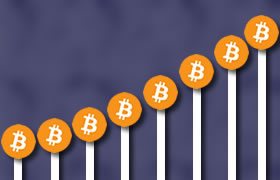Chinese Markets Allow Withdrawals After A Nearly Four Month Moratorium

Bitcoin hit its all-time high of $2,791.69 on May 24th, more than doubling its value since the beginning of the year. Despite its value dropping an estimated 19% in the days following this high, bitcoin has finished the past eight weeks in the green. You might think this is a good thing, taking it as a sign that the digital currency is doing well. But eight straight weeks of growth have only happened twice in BTC history – and both led up to a huge bust.
Bitcoin’s rapacious growth in 2017 has prompted some people to herald the cryptocurrency as the new gold. Jeremy Liew, the brilliant first investor in Snap Inc., believes that BTC will reach $500,000 by 2030. Tim Draper, the founder of prominent investment company Draper Fisher Jurvetson, said: “Long term, Bitcoin is so important to the world economy that I suspect the price will continue to rise overall.”
But there are a growing number of people who are becoming more and more skeptical of the seemingly indomitable currency. A big part of this is BTC’s volatility. Although the price fell after touching on an all-time high, if you look at the overall growth chart for bitcoin, you’ll see that there tends to be a period of large growth that leads to a small drop in value before another bit of growth. This sort of U shape is almost always followed by a second, more devastating drop in value. The last time this happened was 2013 when the value hit a then-high of around $1200 only to eventually fall to around $500, where it would stay for a number of years.
This isn’t a growth trend unique to cryptocurrencies. In fact, it’s not unique, period. Just think of the Dutch Tulip craze or more recently, the housing market crash. A sudden rise in value leads to a burst of overzealous investment, driving up the price of the commodity (in this case, bitcoin) and then leading to an overcorrection in the market. Historically speaking, that’s where bitcoin is heading now. The problem with this cycle of growth is that you never know when the bubble is going to burst. A correction in the market could lead people into a panic, pulling out their money as fast as they can, further driving the value of the currency down.
The bigger problem with bitcoin value falling isn’t just that people might lose their investment or that the overall market might take a hit. It’s that bitcoin is a currency, and whenever one part of the financial system looks faulty, even a small part like bitcoin, the whole thing looks like it might break apart at any minute. This leads to further financial panic. With the anonymity of this virtual currency, there’s no way of knowing until it’s too late how much of an impact it will have on the overall worldwide economy.
Which is what’s leading Business Insider CEO Henry Blodget to pull a 180 on his views of the cryptocurrency. “There’s no intrinsic value,” Blodget said in an interview, warning away those who think the virtual money is the end all be all. “If anybody is persuading you that it should somehow be linked to…gold, put down the Kool-Aid and back away.”
Before this, Business Insider was one of the major proponents of the growing digital currency trend. He’s not the only major player pulling an about-face, though. Analysts from CNBC and other networks who just a few weeks ago were noting the unprecedented growth of bitcoin and its investment potential are now publishing articles about market corrections and how low the value will go.
Nicola Duke, an analytics expert who studies historic trading patterns, noted that the $2,800 mark is where bitcoin could start to make a correction that could cut the value in half. “Bitcoin will probably hit $1,780, and might even decline to $1,470,” said Nicola. She then followed this up by saying it could have continued growth after it corrects itself, though.
Basically, it’s all speculation. No one knows what Bitcoin will do, but a lot of the digital currency’s proponents from just a few weeks ago are now some of its loudest naysayers. Until there is a more regulated and accepted market for bitcoin, as well as other cryptocurrencies, to operate within, Bitcoin Review believes we’re probably going to be seeing more and more of these speculative pieces as the value bobbles up and down.